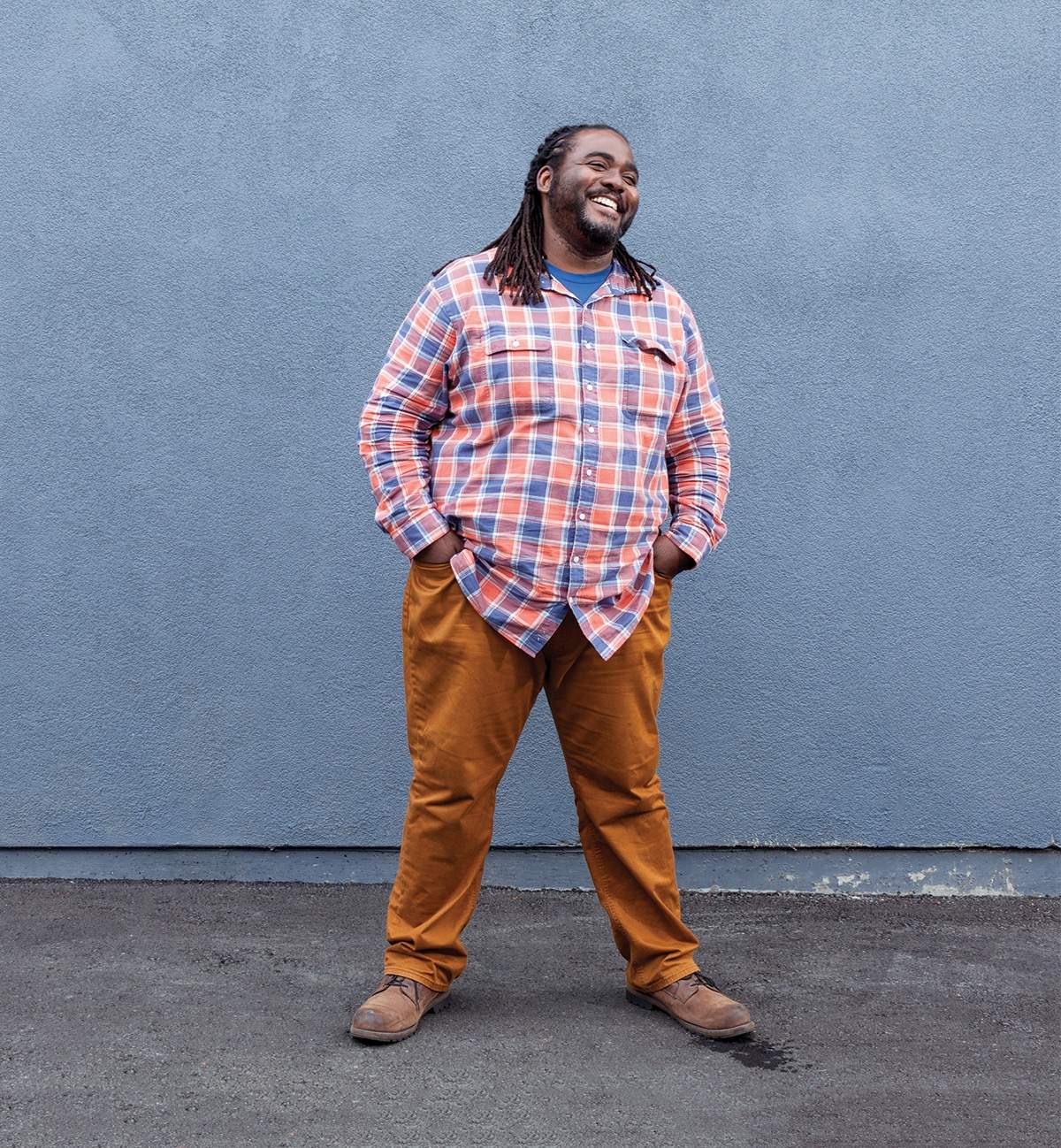It was just lunch, Dave Evans told himself. Just a conversation. Evans was a tall, smooth-talking Silicon Valley jack-of-all-trades with a resume that included heading up the team that designed Apple’s first mouse and cofounding the video game giant Electronic Arts. Lately, he’d been teaching a popular course at the University of California, Berkeley, on navigating life after college, and was wondering if his friend Bill Burnett, the newly appointed executive director of Stanford’s Design Program, would be interested in doing something similar there.
A thoughtful, no-nonsense design geek, Burnett had a similarly wide-ranging portfolio. As an undergraduate at Stanford, he’d gotten swept up in the human-centered design movement, a holistic, interdisciplinary approach to engineering that had revolutionized product design in the ’70s. Over the course of his career, he’d created award-winning designs for Apple’s Powerbook and the original Star Wars action figures, as well as helping launch several successful tech startups.
Evans thought it would take a year of lunches to win Burnett over, but as soon as he laid out his scheme, Bill started peppering him with ideas about how to add design principles into the mix. “This problem has been walking into my office for the past 20 years,” he said. “Why don’t we put together a prototype of the course this summer and launch it in the fall?”
What emerged in the months that followed was a new way of thinking about life and work that, like so many other Silicon Valley innovations, turned conventional wisdom on its head. The fundamental question that Bill and Dave wanted to address was: How do you build a life that works for you? And it turned out that their offbeat approach to design thinking was a surprisingly useful model for attacking this question.
That became clear in the summer of 2007, when they rolled out their prototype to a group of Stanford design students. At the end of the class, when Evans announced that it was time to go, one student stood up and said, “No, we’re not going anywhere.” When Evans asked why, the student replied, “Because we don’t have any other place to have this kind of conversation.”
For most of us, “passion is an end product. You discover passion by working hard on something.”
The course was a hit, and a few years later, the university asked Bill and Dave to create an expanded version that would be open to all juniors and seniors, not just design students. That class, one of the most popular electives at Stanford, has spawned a broad range of product-line extensions, including workshops and online classes for the general public and recently the New York Times #1 bestselling book, Designing Your Life.
At first, I was skeptical. Ever since I was a teenager, I’ve been a how-to junkie, yearning in vain to find that one ineluctable truth that was going change my life forever. I’ve dabbled in all kinds of self-help workshops over the years, and after reading the works of everyone from Epictetus to Marcel Proust to Brené Brown, I doubted that a couple of Silicon Valley engineers, no matter how savvy, had anything new to offer on the subject. But I soon discovered, after meeting Evans and Burnett, that they weren’t interested in philosophizing. Their program is a practical blend of mindfulness, self-compassion, and creativity. “We’re not trying to get you to do anything,” says Evans. “We’re trying to build ideas and tools that give you access to you.”
In essence, design thinking is about building your way forward by creating ideas and testing them in the real world. It’s a way of “sneaking up on the future,” explains Evans, adding that it works particularly well in situations where you don’t have a lot of hard data to rely on. The starting point is exploring who you are and what you want to do with your life. Many of us assume that there’s only one right answer to that question, but once you start looking at your life with a designer’s point of view, a multitude of creative possibilities emerge. “Life is not a problem to be solved,” says Burnett. “It’s an adventure to be engaged.”
When Evans was a sophomore at Stanford, his dream was to become a marine biologist. But when that didn’t work out, he found that the adults he turned to for advice were as clueless as he was about what he should do next. “Everybody just wanted to hold me accountable for an answer I didn’t have,” he recalls. “So I had to figure it out the hard way, by trial and error.”
And what he learned in the process was that “making it up as you go along is actually the only thing that we have available to us. You just want to get really good at it. To be a competent person at winging it.”
That’s particularly true in the shape-shifting world we live in today. “The only job we all know we’re going to need someday is the job of getting the next job,” he says. “You could make the argument that life design is what life is. We’re all designing our life all the time.”
Making it up as you go along is actually the only thing that we have available to us. You just want to get really good at it.

All of this sounded fine for twentysomethings making their way into the workforce for the first time. But what about the rest of us? Would Bill and Dave’s life and vocational “wayfinding,” as they called it, work for someone stuck in a stifling midcareer job? Or, in my case, someone who had held big jobs in the media industry but was now searching for creative ways to find fulfillment in the next phase of my life?
That was the question tugging at me as I walked onto the set of Bill and Dave’s online workshop at the CreativeLive studios in San Francisco. The diverse mix of participants was encouraging. At my table, for example, were two entrepreneurs in their 50s, Diane and Patty, who’d recently launched a tech startup targeting women re-entering the workplace, and three thirtysomethings: Matt, a project manager for a large construction firm; Louise, a freelance event planner who dreamed of starting her own media company; and Derek, an Iraq war veteran, businessman, cartoonist, and all-around free spirit.
To kick things off, Burnett proposed that it was time to reframe the age-old question: What do you want to do when you grow up? The real issue, he said, was: What do you want to grow into next?
In Burnett’s view, one of the most common obstacles people face trying to make that leap is the widespread “dysfunctional belief” that once you find your “true passion,” everything else will magically fall into place. But research by Stanford’s Center for Adolescence shows that only 20% of people age 18 to 26 have a clear vision of what they want to accomplish in life and why. For most of us, Burnett observed, “Passion is an end-product. You discover passion by working hard on something. If you have a passion, that’s great. But this passion thing leaves eight out of 10 people out of the conversation.”
Another motivation killer is the idea that if you haven’t figured out your life by a certain point in time, you’re already too late. “That’s ridiculous,” said Burnett, explaining that several longitudinal studies show that most people don’t fully form their adult self until 35 or even 40. “And after that,” he added, “you get to reinvent that self over and over again.”
In the days leading up to the workshop, Bill and Dave had asked us to compose two short statements on how we viewed work and our philosophy of life. The idea was to get a sense of how strong the connection was between what we believed and what we did for a living.
Reading my statements aloud to my table-mates, I could immediately hear the discordance between them. My work statement sounded old, like something I might have written in a resume 20 years ago. It focused primarily on personal achievement and “using my gifts as a writer, producer, and artist to raise awareness and inspire positive personal and social change.” Those were worthwhile goals that had fueled important changes in my life. But what mattered to me now was helping others expand their awareness in a more direct way. As I wrote in my life statement, “My dream is to align my inner values with the way I operate in the world. To be genuine and authentic, to be compassionate to those who are suffering, to act and make choices based on the knowledge that we are all part of something larger.”
That felt right, but how to turn such lofty aspirations into action?
Bill and Dave had a simple answer: Build a prototype. Or, rather, several prototypes of the new life you want to live. That led to a thought-provoking exercise called “odyssey planning.” It involved imagining three dream scenarios and drawing a timeline of how each would play out over the next five years. The first one, Evans suggested, should be based on what we were currently doing, the second on what we’d most likely do if that option came to an end, and the third on what you’d love to do if time and money were no object.
Why three scenarios instead of one? Because it stimulates creativity and cross-pollination. In a recent study, researchers at Stanford’s Graduate School of Education looked at two groups: one that started with three ideas and came up with two others en route to their final goal, and another that began with one idea and later produced four others. Even though both teams eventually wound up with five ideas in total, the researchers found that the three-idea group generated solutions that were far more creative. “Designers have known this all along,” Evans and Burnett write in their book. “You don’t want to start with just one idea, or you’re likely to get stuck with it.”
These exercises generated a lot of buzz at our table. Louise talked excitedly about her first two scenarios: partnering with a digital dating company to produce blockbuster events and launching a media company focusing on creativity. But her eyes really lit up when she rolled her third big idea: becoming a broadcaster who interviewed famous creative people on TV. “I love doing this,” she said, “because you don’t have to rock everything in your life. All you have to do is experiment.”
Matt had a similar revelation. His “wild and crazy” idea was to build a surfer retreat/mindfulness center in Mexico for people to escape from their cell phones and recharge. “I feel most myself when I’m helping others,” he said. “Real kindness puts a new spin on life.”
As for me, I imagined 1) expanding my work as a journalist and consultant, 2) training to become a meditation teacher and/or executive coach, and 3) writing a historical novel and painting my masterpiece. These weren’t big, hairy, audacious ideas, but, taken together, they seemed to make sense. Which, according to Burnett, is usually how it works. Most life design students don’t drop everything and go chasing after their most outrageous idea, he said. They continue doing what they’re doing, but enrich the experience with ideas from the other scenarios. The point, said Evans, was “getting more out of life rather than cramming more into it.”
We all have at least one story in us of when we’ve changed our perspective, and have seen how a failure turned out to be the best thing that ever happened.

The next step was testing the ideas in the real world. That meant having “prototype conversations” with people who are already living the life you’ve imagined for yourself. No matter how ludicrous your idea, said Evans, there’s usually someone out there doing the thing you want to do. He cited science fiction writer William Gibson: “The future is already here. It’s just unevenly distributed.”
The trick is to focus on your interviewee’s personal story rather than hitting him or her up for the job. “Everybody loves to tell their own story,” said Burnett, especially if you don’t pull out your resume in the middle of the conversation. Another proviso: Cast a wide net. It’s better to over-report the story than to try to make important decisions about your future based on skimpy information. Plus, if you engage in enough conversations, one of them might even turn into a job offer.
What about procrastination? “The number one thing we see that holds people up is fear,” said Burnett. “But fear is one of the things we know how to master. You take very small steps over and over. That’s what we call ‘failure immunity.’”
A case in point is Kathy Davies, the managing director of the Stanford Life Design Lab, whom I interviewed after the workshop. “My tendency used to be, ‘I’m going to revamp everything and make a New Year’s resolution for the whole year,’” she said. “The problem is that doesn’t work because you’re intimidated from the start and you’ve bitten off more than you can chew. That’s why I love the idea of micro-changes. When we do product design, we follow people around and see what they do and then design products for them. To give yourself the same kind of scrutiny is a smart thing because it yields interesting information you can use to make small changes. The beauty is, one, you notice things about yourself that you weren’t paying attention to before and, two, the idea of making a small change is very empowering.”
This kind of self-exploration is not just a gambit; it’s the heart of the process. As Evans and Burnett describe in their book, designing your life involves starting with who you are, having lots of ideas and trying things out, and then making the best choices you can. As you do that, they write, “you grow various aspects of your personality and identity that are nurtured and called upon by those experiences—you become more yourself. In this way you energize a very productive cycle of growth, naturally evolving from being, to doing, to becoming. Then it all repeats as the more-like-you version of you (your new being) takes the next step of doing, and so it goes.”
When you approach life this way, they add, “Failure is just the raw material of success. We all screw up; we all have weaknesses; we all have growing pains. And we all have at least one story in us of an occasion when we’ve reframed a particular failure, where we’ve changed our perspective, and have seen how a failure turned out to be the best thing that ever happened.”
The secret of good decision-making, according to Evans, is engaging your whole being in the process, not just your cognitive side. “People often say, ‘I want to make a really good decision, not an emotional one,’” he said. “But there’s no such thing as an unemotional decision.”
The problem, according to neuroscientists, is that the emotional wisdom center of the brain isn’t directly linked to the part of the frontal lobe connected with language. And, because we place such a high value on rationality in our culture, we don’t spend a lot of time developing our discernment of those feelings. “The thing that you think of as yourself,” said Evans, “is heavily shaped by your emotional wisdom. If you can combine your EQ and IQ, you will make better decisions.”
This doesn’t happen overnight. One of the best ways to cultivate emotional intelligence and other forms of intuitive knowing is to engage regularly in meditation, yoga, art-making, and other practices. And it’s important to make it a regular habit, quipped Evans, “not just something you do once, like going to Disneyland.” In his case, he devotes 20 minutes a day to silent meditation, or “centering prayer,” and studies poetry once a week, trying to experience the words kinesthetically. Similarly, Burnett practices mindfulness meditation (using the Headspace app), goes to a figure-drawing class every week, and regularly takes part in a long-standing men’s group.
Tapping into your imagination also helps. Toward the end of the workshop, Bill and Dave asked us each to select one of our life scenarios and write about what it would be like to live that story. I was surprised by how easily the words flowed, and the same was true for virtually everyone else in the room. That was an example of “the EQ-IQ combo” in action, said Evans. Because of all the work we’d done earlier in the workshop, he explained, the emotional reality of our story was available to our unconscious mind and our conscious verbal mind was happy to write it down.
During the discussion afterward, my tablemate, Diane, had an interesting insight. She said that “putting the narrative out there—even though it didn’t exist—made it feel as if it was really happening.” That was the whole point, said Burnett. “It’s not good enough just to have an idea,” he said. “You have to put that idea in the future and make people want it. And the more authentic it is, the more people will want to help you.”
After the workshop ended, one question still puzzled me: How does life design evolve as we get older? When I called Evans a few weeks later looking for an answer, he suggested (not surprisingly) reframing the question: “Do you mean: At what age do you notice that people don’t care about their life anymore and are just waiting to die? We just haven’t noticed that. Everybody thinks their life matters.”
In general, he said, he found it much easier to work with people who’d had some life experience because they appreciated the restraints a lived reality includes and held their plans with a little more looseness. But, he added, older people sometimes get blocked because of their overly well-developed identities. “They’ve been doing the same career for 30 years and they’re scared of becoming a different version of themselves,” he said. “And they’re pretty convinced that the world isn’t going to let them. Twenty-year-olds don’t have that problem.”
Evans told the story of his sister who decided to get her PhD at age 59, even though she already had a full-time job as dean of a graduate school. The program would take six years of intense work, and she worried that she wouldn’t have the energy to complete it. But her husband helped her reframe the problem, saying, “Those six years are going to go by anyway. It’s just a question of whether at the end you’d like to be a person who has a doctorate.”
“That’s why reframing is such a big deal,” said Evans. “Are you framing what you’re asking of yourself in the most generative, open-minded way possible? Because that’s the context in which you want to make the decision. To give yourself the best possible chance of having things work out.”
As he related this story, I was reminded of the sign at Stanford’s design school that reads You Are Here with a big arrow pointing at the floor. “That’s where we’re coming from,” said Kathy Davies. “You are here. Be present. Be here physically and mentally. Because that’s where it’s happening.
“Very often, we’re thinking about the past. All that backstory. Or we’re worrying about what’s going to happen five years down the road. But you’re here now. What do you want to do today? There’s something beautiful about that. Because that’s all we really have.”
Odyssey Planning
Here’s a way to contemplate how you would “build” your future—like a designer—that helps you be more creative and not get stuck in a rut. Imagine three dream scenarios and draw a timeline on how each of these would play out over the next 5 years:
LIFE 1
A continuation of what you’re currently doing
LIFE 2
What you’d most likely do if option 1 came to an end
LIFE 3
What you would love to do if time and money were no object
See Designing Your Life, by Bill Burnett & Dave Evans (Knopf 2017)
Think Like a Designer
In their book, Designing Your Life, Bill Burnett and Dave Evans describe the “mindsets” designers use that can help you “build anything, including a life you love.”
Be curious
“Curiosity makes everything new,” write Evans and Burnett. “It invites exploration. It makes everything play. Most of all, curiosity is going to help you ‘get good at getting lucky.’”
Try stuff
Designers have a bias to action. They make things happen. They create prototype after prototype, often failing, but failing better. “Designers embrace change,” the authors add. “They are not attached to a particular outcome, because they are always focused on what will happen next—not what the final result will be.”
Reframe problems
Are you working on the wrong problem? Reframing is a good way to get unstuck. It allows you to step back, examine your biases, and open up your mind to new possibilities. For example, if you’re stuck in the dysfunctional belief that you should already be where you’re going, here’s a simple reframe: “You don’t know where you’re going until you know where you are.”
Be mindful of the process
Some of the best inventions—the Slinky, Super Glue, Play-Doh, to name a few—hap-pened because somebody made a mistake. That’s why letting go of your first good-but-not-great solution is often an important part of the process. When you think like a designer, “you learn to be aware of the process,” write Evans and Burnett. “Life is a journey; let go of the end goal and focus on the process.”
Engage in radical collaboration
While great art is often a solitary endeavor, great design is inevitably a team effort. That’s especially true of life design. “Many of the best ideas are going to come from other people,” they add. “You just need to ask. And know the right questions to ask.” Most of all, it’s important to be attuned to life as it really is. As Burnett is fond of saying, “No life plan ever survives its first contact with reality.”
After School
For Ashanti Branch, life design principles are a key to empowering young people.
Ashanti Branch is founder and executive director of the Ever Forward Club, an Oakland, CA-based group that supports Latino and African-American high school students to engage with school and achieve their potential. The Ever Forward Club has helped 100% of its members graduate high school, and 93% have gone on to attend college. Branch studied life design through a Stanford fellowship in 2015-2016.
Mindful: What led you to study design theory?
Ashanti Branch: Ever Forward Club started out as a small volunteer-run nonprofit. When we started, I was doing it after work and on weekends and holidays, while teaching math full time. I had this dream of it being bigger, and believed it was going to happen one day, but didn’t know how.
How did design thinking change that picture?
Before D-school, it was like I was rowing a boat, always rowing and rowing. Now that rowboat is more like a motorboat, with a perpetual energy of its own. It was absolutely life-changing for the organization. Through D-school, I came to understand three things: who our users are, how to tell the story of what we were trying to change, and how small, easy changes could elevate our work.
What concepts from life design do you emphasize with your members?
The idea that, if you decide there’s something in your life that’s not working, you can change it. If you can’t change it, just name it—maybe it’s something you can’t change right now, but within a few years, you will be able to make some big choices. What can you do to prepare yourself for this? What small things can you do to make it better right now?
I don’t have an answer for all situations, but I’m always trying to help young people paint the picture they want to happen.

And then when they recognize that they can help other young people going through similar stuff, it kind of pulls them out of their own problems. With empathy, they invest in others, so not only can they come up with more creative solutions, they also find easier solutions for themselves.
Is that part of the “creative toolbox” idea in life design?
I use the analogy of an emotional toolbox. When I was dean at my old high school, I saw so many young people sent to the office for acting out in class. They lacked the emotional knowledge to deal with situations. So to help them visualize what they were doing, I would tell them, ‘In your toolbox right now, you’ve only got a feather and a hammer. Sometimes you need a little sandpaper or a screwdriver.’ They needed to come into a situation with the right emotional tools to create the result they want, using their words and attitudes and thought processes.
There’s a lot of mindfulness to that approach.
It’s always about pausing when you’re worked up, taking a breath, and asking how can I do this in the best possible way? In a classroom, how we react and respond will make those relationships go really well or begin to go poorly. I do the practice so that they can model me doing it, and I tell them why I’m doing it.

